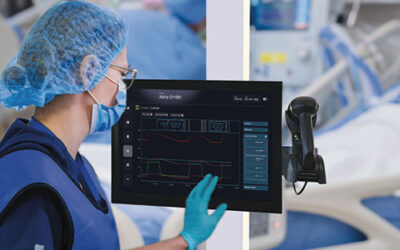This blog was originally published in December 2020 and was updated in May 2023.
Since COVID-19, telemedicine has continued to increase access to healthcare, as in-person visits were not an option for patients. Now that facilities are open again, telehealth implementation remains an essential undertaking for healthcare providers. In fact, the adoption of telehealth continues to expand at a rapid pace, with an increase of 7.3% from just December 2022 to January 2023. Clearly, it’s still a relevant resource for patients.
More patients are using telemedicine (and even more of them feeling optimistic about using it in the future), with 76% of survey respondents saying they’re interested in utilizing telehealth moving forward. Implementing a telemedicine strategy now can have massive benefits for your healthcare organization down the line.

Here are the top five considerations as you establish your telemedicine system:
1. Scalability across the enterprise and modalities of care
How are you currently leveraging the modalities of care? From text messaging to asynchronous engagement and complete clinical assessments, scaling up to have a full remote encounter provides convenience for patients and multiple touchpoints for care providers. Using a variety of digital technology tools, such as video and medical devices, patients can receive the care they need when and how it is convenient for them.
2. Seamless device integration
Medical device integration for telemedicine applications enables you to launch a telehealth platform and engage with patients directly to capture a broad range of information from the different connected medical devices (e.g., vitals data, heart and lung sounds, images from an otoscope, ECG reports). It’s the holy grail of telemedicine. Just as it’s crucial to collect vitals in a brick-and-mortar care setting, you should also do the same in virtual care settings to ensure consistency in the quality of care.
Every use case has its own specific needs and device requirements. Integrating a variety of devices is essential to ensure the best high-acuity encounter and maximize the potential of telemedicine.
3. Integration vs. interoperability with EHR
EHR integration is also a critical factor in your telemedicine implementation plan and a mandatory feature for a scalable enterprise platform that provides continuity of care. Two core concepts are needed to maximize the workflow for respective users within an EHR and a telehealth platform. Understanding the difference between interoperability and integration is critical.
- Integration: A provider launches the telehealth, or virtual care, encounter from within the EHR system, and pertinent patient demographic data is brought into the encounter. This allows the provider to maintain a consistent workflow, and data or documents collected during the virtual visit will be seamlessly recorded to the patient record.
- Interoperability: A separate platform outside of the EHR will need to be open when it is time for a virtual visit. Upon launching the telehealth platform, providers can perform their virtual exam/visit, and then captured data can be sent to the EHR for correct placement within the patient’s record.
4. Simplicity is the key to user adoption
Simplicity is considered the “magic word” for user adoption — the easier you can make accessing telemedicine for both the patient and providers, the more it will “stick.” If the platform is too complex, it can slow down the process and make it more difficult for healthcare providers to manage their patients. A simple platform can streamline the process and make it easier for healthcare providers to manage their patients’ care.
5. Telehealth has a lot more to offer than a video-only interface
Video is exceptional in most cases, but it’s not an enterprise play to meet the needs of care specialties and patient engagement modalities. Performing a virtual clinical assessment on your platform enables your system to streamline services and consolidate to one platform, so you have the leverage to achieve high-acuity encounters no matter the location.
At AMD Global Telemedicine, we believe that the pathway to providing optimal care is to reimagine the overall delivery of care model where virtual services complement the broad continuum of care for a given patient. Telehealth is not about video quality, and it’s not just about seamless device integration –– it’s also about providing an agile delivery of care model that best supports the care needs of patients and physicians and increases engagement. It’s about leveraging a single platform across the community of care that is agile enough to support unique workflows.
Read our Buyer’s Guide to learn more about how you can optimize your outcomes after implementation.





